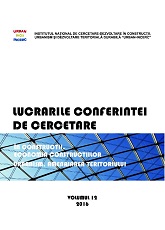Porţi intermodale ale oraşului Bucureşti
The intermodal hubs of Bucharest
Author(s): Mihaela Hermina NEGULESCU
Subject(s): Human Geography, Regional Geography, Applied Geography
Published by: INCD URBAN-INCERC
Keywords: urban planning; mobility; intermodal hubs
Summary/Abstract: Bucharest, as the majority of big cities, but more than many of them, bears the negative consequences of a very high motorization rate and of an irrepressible traffic, generated on and by its territory of influence. The city’s polarizing force express itself through commuting pendulum flows from and towards its periurban settlements, who are spatially and functionally related to it. In a major share, the commuting trips are made by cars that enter, travel and park within Bucharest, widening the negative impacts of its internal traffic and fleet of cars. The best solution to mitigate traffic congestions, reduce pollution, enhance road safety, release and rehabilitate public space is to provide an efficient regional transportation system at the scale of the quotidian mobility territory (working catchment area delimitating the functional urban area) and the implementation of a coherent mobility policy through consensual packages of measures. This type of complex and expensive transportation supply can be achievable only at a long term horizon, whilst solutions adequate to the current context must be implemented as soon as possible. The paper addresses the solution of organizing "intermodal gates” for the city, as effective equipements for modal report, providing good conditions for fast, convenient and comfortable transfer from car to public transportation, in particular to the subway. Priority locations for such intermodal hubs are those at the entries within Bucharest of A1, A2, A3 motorways, from which large motorized flows are discharging on the internal road framework of the city, already overcharged. The majority of those flows is of commuting trips, which have high potential for modal report towards public, collective transportation. The "Intermodal Gates" are a transfer hubs system with high potential for leading, within Bucharest city, to the mitigation of the traffic originating from its territory of influence. For this “carrot” potential to be efficiently harnessed, “stick” measures also must be taken to limit, condition and make expensive the access and parking in the city, mainly in its center. The work is based on the author’s research undertaken within the project SAFENET - Research on estimation and enhancement of intrinsic safety performances for urban traffic networks, PN-II-PT-PCC A-2011-3.2-1439 conducted through the “Partnership in priority areas” program - PNII, PCCA Tip 2, conducted between 2012-2016 with the support of ANCSI CNDI – UEFISCDI, and addresses proposals of the author during the preparation of the Sustainable Urban Mobility Plan for Bucharest-Ilfov region, 2014-2015.
- Page Range: 13-22
- Page Count: 10
- Publication Year: 2016
- Language: Romanian
- Content File-PDF

